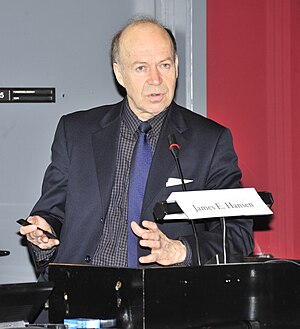I just finished Storms of My Grandchildren, by James Hansen, who is director of NASA’s Goddard Institute For Space Studies. I was curious to learn how climate scientists came to some of their conclusions about the effects of CO2 and other gasses upon the planet and he did not disappoint . He shows a number of graphs and walks the reader through their implications.
Some things surprised me. I assumed that conclusions about global warming fell out of weather modeling. This is not at all the case, because those models simply aren’t accurate enough to look at long term trends (okay, I admit it, how naive can one be? If they can’t predict the weather a week from now, how can they possibly predict what will happen in ten years?). Instead, it is based upon historical data such as ice cores and basic energy balance equations, along with growing accuracy in ocean temperature measurements. Of course, there is a lot more to it than that, and scientists have looked at the problem in a lot of ways. I didn’t pay enough attention to the details to be able to repeat them here, so you would have to read his book for yourself. But he certainly convinced me that the science is sufficiently sound to know that we have a serious problem on our hands!

The details about climate science are interspersed with his experiences unsuccessfully trying to convey the science to politicians and his ideas about how to address the problem. If one likes this kind of thing, he gives lots of names. True confession: I found his lists of people in government a little tiresome and skipped some of this.
Because global warming interests me, and I think it is one of the most important issues of our times, I plan to do lots more reading about it. If our world could potentially warm enough to raise the levels of our oceans even one foot, let alone two, and change weather patterns even a fraction of what James Hansen suggests, the world we know would no longer exist and millions and millions of people would suffer. To me, this doesn’t seem like a risk worth taking, compared to the risks associated with doing something, right now, to slow down the world’s production of greenhouse gases.
Related articles
- NASA Visualization Shows Global Temperature Changes (VIDEO) (environmenteng.wordpress.com)
- Climatologist James Hansen on “Cowards in Our Democracies” (thinkprogress.org)
- Spiegel: ‘The Truth Peddlers’ – Smoke and Mirrors in the Climate Debate (junkscience.com)
- Fox News: Polar Opposites and Science
There’s been a lot of debate about climate change. This article cites Dr. William Happer, who sounds pretty impressive (he’s at Princeton) until you realize that his research has nothing to do with climate. He studies spin-polarized atoms and nuclei. I have to wonder how he suddenly became an expert on global warming and why he is so sure it isn’t caused by CO2. Just wondering.
- Debate Over Global Warming/Climate Change Heats Up – Voice of America (blog) (blogs.voanews.com)
Still, I like to learn about any science showing humans are not causing global warming, so, if this book gets translated into English, I just might have to have a gander:
- Spiegel: ‘The Truth Peddlers’ – Smoke and Mirrors in the Climate Debate (junkscience.com)

